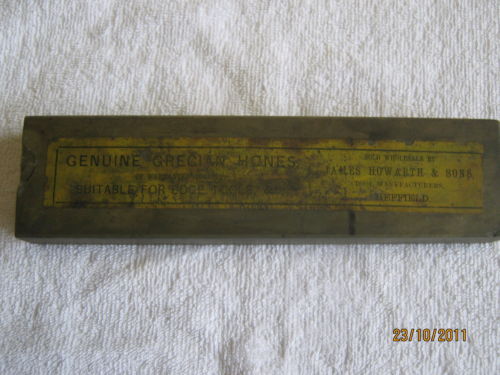Results 11 to 12 of 12
Thread: Info about Nova Scotia hone
-
07-08-2016, 05:25 PM #11

Looking forward to pix and labels. Maybe this is the "Canada" stone as labelled that looks like a Hindostan? Maybe this is the "Magog" that looks like a Washita?
Striving to be brief, I become obscure. --Horace
-
07-08-2016, 08:36 PM #12

From the description, I can only assume we are talking about an Arkansas like Novaculite stone, with different grit and "porosity/density". I suppose, they also look like the Hindostan, with the last part being a guess.
Also, here is one more photo of a James Howarth stone, a Grecian (UK) one although it won't be a very clear one I expect:

Edit;
I've just found some old mails for this specific stone... from Mr. Neil Miller,
"James Howarth had a very good reputation. The business really began in 1835 when he went into business with Henry Taylor as 'Taylor & Howarth' in Broomhall, Sheffield. The partnership with Taylor ended in 1842 and after that James Howarth became the name of the company. They primarily produced edge tools for carpenters, etc, and won gold medals at several exhibitions. They added other lines - such as hammers and even ice-skates, but never razors as far as I know. They were also retailers of sundry items that were needed by carpenters, etc, such as hones - they had a large variety of items as general merchants and issued catalogues of their wares. In 1857 they moved to the Broom Spring Works at Bath Street, Sheffield. In 1863 the firm became James Howarth & Sons. The firm ceased trading in 1913 and the name was acquired by Robert Sorby & Sons in 1922 - Robert Sorby's firm underwent the same fate and was acquired by another firm, too.
So your stone dates anywhere between 1863 and 1913, but I would imagine it is from somewhere nearer the turn of the century, maybe 1880s - 1910"Last edited by Vasilis; 07-08-2016 at 08:41 PM.
-
The Following User Says Thank You to Vasilis For This Useful Post:
Hirlau (07-09-2016)


 10Likes
10Likes LinkBack URL
LinkBack URL About LinkBacks
About LinkBacks






 Reply With Quote
Reply With Quote